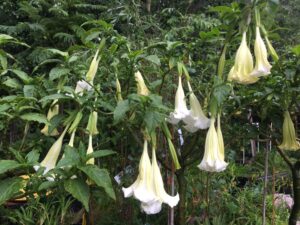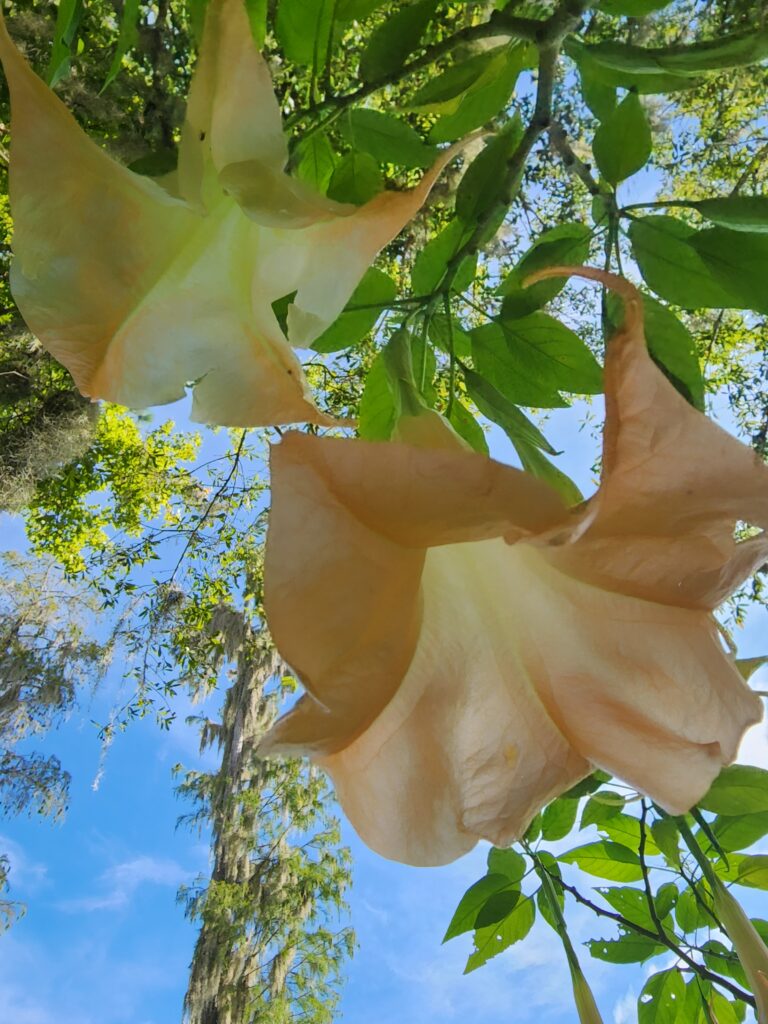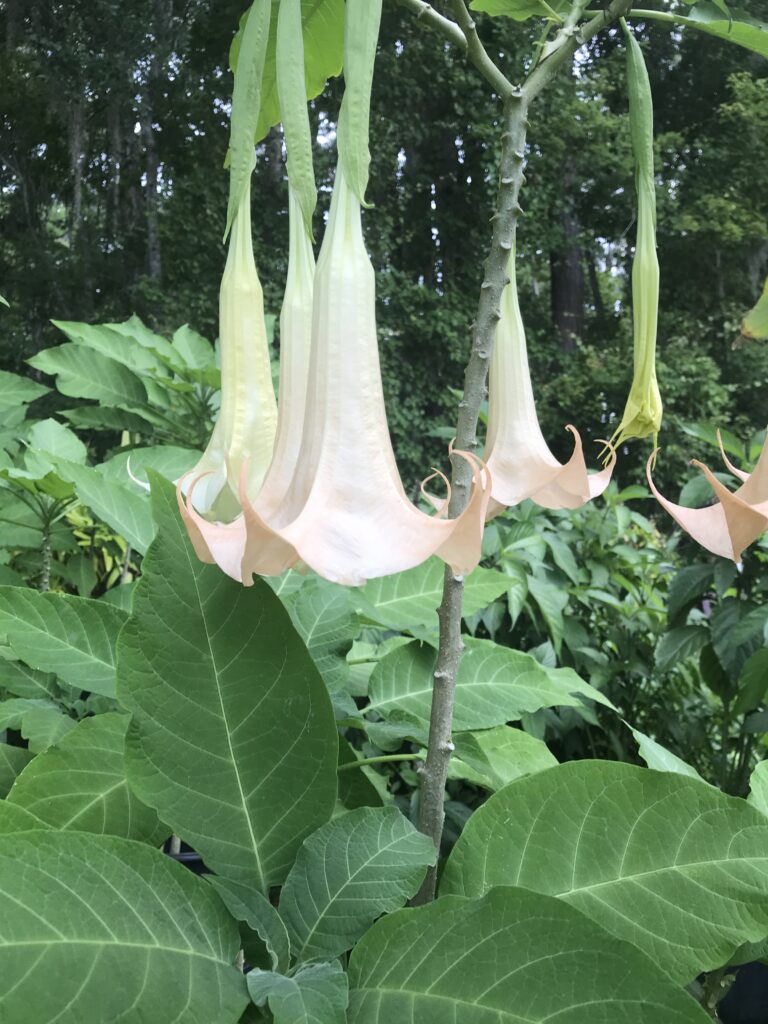S & J Nurserys Guide to Growing
Angels Trumpet Trees
for Northeast Florida, Jacksonville | St. Augustine area Landscapes
(Brugmansia spp.)
Origins and Best Use of Angels Trumpet Flowers / Brugmansia spp. for the Northeast Florida Jacksonville | St. Augustine area home Landscape:

– Angels Trumpets are truly a tropical plant selection. They are cold sensative in North Florida and only considered a root hardy plant selection although in the right microclimates these plants often sustain minimal winter damage.
– Originally thought to be from South America there are now no longer any populations of the seven species of the genus Brugmansia left in existence in the wild. While human populations have kept this genus alive as ornamental plants Brugmansia has been listed as extinct in the IUCN Threatened species listings. https://www.iucnredlist.org/species/51247699/58913403
CAUTION: Like other members of the Solanacea family (nightshade, includes tomato plants by the way) Brugmansias are toxic all parts of the plants are toxic to humans and animals when ingested with the seeds and leaves being especially dangerous. Much is said about Brugmansias toxic alkaloids and their recreational abuses but perhaps author Christina Pratt ( An Encyclopedia of Shamanism) sums it up perfectly. She states” Brugmansia induces a powerful trance with violent unpleasant effects, sickening after effects, and at times temporary insanity” These hallucinogens are often characterized by the complete loss of awareness that one is hallucinating, disconnection from reality (psychosis), and amnesia of the episode entirely. tales in my industry from curious college Horticulture students include the fact that the toxins seem to combine the fact that you are both unaware you are hallucinating and experiencing horrifying hallucinations at the same time. “Violently unpleasant” is exactly every tale I have ever heard. It is my opinion that its absolute idiocy to intentionally ingest it. If that is not enough to dissuade you perhaps there really is just no help for humanity. But I will try one more time….There is a report in the European Archives of Psychiatry and Clinical Neuroscience 256 of a young man that amputated his own tongue and genitalia after drinking a single cup of Brugmansea tea.

Now that I feel I have done my civic duty to dissuade you I have grown these plants for years and years right along with many subtropical and tropical gardeners in Florida as the wonderful unique ornamentals that they are with never a need to put any part of one in my mouth! Just like every other ornamental shrub and tree that I have grown, I look at it rather than eat it, but I do tend to plant them in areas away from foot traffic and pets. So…to each their own I suppose. If you decide to add one of these rare treasures to your garden here is some information that may help.
– COLD TOLERANCE: Brugmansia can be considered root hardy in Zones 8-9 and Foliage hardy in zones 10-11. When planting them into the Northeast Florida expect cold winter seasons where we get hard freezes ( blow 29 for multiple hours) to damage both the foliage and the stems and for the plant to take some time in the spring to recover and be sprouting again by late May and begin to regrow rapidly in June and July. Its just part of the bother of growing these in our climate zone and you should consider yourself fortunate when we have a winter that doesn’t do much damage to them or you have an ideal microclimate in which to grow them through the winter with no damage.
– Great as an ornamental flowering tree for a smaller scale tree as an underplanting araoung larger Oaks or Pines and Maples that will keep the frost off but allow enough light for these to bloom well ( they need 5 or moree hours for best blooming).
Foliage of the Angels Trumpet / Brugmansia:

– The plant is evergreen in frost free areas and will receive cold damage on the foliage in a frost. They should be protected at 32 degrees or can be left to winter and regrow in the spring and summer months the following year. large 8-12 inch light green leaves.
– Foliage is cold tolerant to 32 degrees and will quickly regrow from its roots or stems the following spring in the Jacksonville and St. Augustine area gardens.
– As with all sub tropical plant selections, they are particularly responsive to their individual planting location. When planted on the south side of the house away from north winds, or where receiving some frost protection from larger trees or nearby buildings. you may get only foliar damage. If planted into open exposed areas in full sun you may get leaf and stem damage. If in a protected area you may get no damage at all. Utilize your yards frost free microclimates for all of your tropical and subtropical plant selections.
Blooms of the Angels Trumpet / Brugmansia spp. :
– Blooms intermittently during spring summer and fall are make such a stunning display. the trumpet shaped blossoms may be 6-12 inches in length and come in shades of white, yellow, orange, and red. Blooms may be single double and even triple and tend to hang down from the branches like trumpets from the sky giving the plant its common name. They are often confused with Datura ( Devils trumpet Plants) that have a similar appearance but are shorter bushier shrub type plants that typically turn their trumpets skywards. Clever right? Easy way to tell which one you are looking at… Whos blowing those horns? Although I feel a bit guilty giving the gorgeous Datura shrubs such a bad association, after all their chemical compounds are the same but alas they get the worst end of the “bad plant stick”. And for those of you that are interested in taxonomy, some confusion among the genus may come from the fact that Brugmansia was indeed first classified as Datura by Linneaus and was changed later on and named after Dutch naturalist Sebald Justinus Brugmans and then debated for a while until some farther research was done by in 1973 by T.E. Lockwood and has remained as Brugmansia now as a result of that morphological comparison for quite some time. his very detailed breakdowns of the form and structure of the platns have left them categorized as Brugmansia ever since.
Preferred Exposure for Angels Trumpet / Brugmansia :

– Angels Trumpet will grow in part sun situations or light dappled shade underneath taller canopy trees but flower the best when receiving adequate light. I find planting them in morning sun and afternoon shade Ideal for flowering.
In Northeast Florida, a plant receiving 6 hours or more of sun exposure is considered to be planted in a full sun location, afternoon sun during the summer where it remains above 80 degrees till 7 and 8 PM is the same as an all day sun exposure on some plants and wont be ideal for these shade loving plants. filtered light under taller growing shade trees. Plants may have a bit of a bloom reduction in lower light areas under thick canopy trees but will be better protected from damaging winter frosts so there is a decent trade off value there.
– Best if planted on the south side of the house away from cold north winds, up next to a fence or near the foundation of a home or other building, or near larger shade trees that will protect these tropical plants from frost. Or plant on the west side of a home or building.
Soil Preference / Salt tolerance of the Angels Trumpet Tree:
– The plant prefers moist, well-drained, fertile, soil that has high organic matter content. Amend with compost when planting into dry sandy soils.
– poor salt tolerant
Size and Growth of the Brugmansia spp. / Angels Trumpet Trees:
Size: can reach heights of 10-15 ft ft in height and 10 ft in width if left unpruned to grow up as a small scale ornamental tree .
Growth Habit: Rather upright when young developing a naturally vase shapedor rounded canopy with some pruning for fullness.
Growth Rate: Fast growing plant, expect approximately 1-2 ft of growth annually in the first few seasons and an established plant that burns to the ground in winter can regrow easily from its mature root system to 6 ft and blooming by the end of the summer months.
Water Requirements of the Brugmansia / Angels Trumpet Tree :
– Once established these plants require less frequent watering but are not highly drought resistant and should be given supplemental irrigations during droughts. Although much more durable once established in the landscape, daily hand watering is necessary to get the plant rooted and growing on its own after being planted in the ground from an S & J Nursery container.
I have successfully grown these plants in both shaded areas with soil that stays continuously moist and in sandy soils in higher light locations, for me these are not picky about soils conditions but are one of the first to show signs of drought stress in sunnier locations in my home landscape. I consider them thirsty plants, but have very sandy soils. What I love about them is they are very forgiving, when you give them a little extra water they perk right back up like they never missed a beat, and its not a frequent request as Florida is normally receiving more than adequate rainfall.
Care of the Angels Trumpet / Brugmansia in the Northeast Florida Landscape:
– Amend sandy soils generously with compost to help your Angels trumpet plants get established quickly.
Here is a link to S & J Tree Farm and Nurseries Guide to Planting Your Plants into their New Home
– Water every day during the establishment period after planting in the garden from an S & J Nursery container. Be sure to continue supplemental irrigation during the hot summer months during prolonged droughts. Here is a link for S & J Tree Farm and Nurserys information on how to water your newly installed plantings in the Northeast Florida landscape
– Fertilize each year just after trimming in the spring after a cold recovery or in summer with a good shovel full of garden compost or use Osmocote or another slow release plant food spring, summer and fall.
– When temperatures drop under 32 degrees you may opt to protect your foliage and or stems from severe frost damage by throwing a blanket or other breathable fabric over the top of the plant making sure the edges touch the ground to trap in the heat from the soil.
– Make your last summer pruning in August giving your Angels Trumpet tree ample time to recover growing new foliage that will harden off before winter arrives for us here in late December. Pruning too late into the fall will cause flushes of cold sensitive new growth that is sure to freeze during even a light frost that hardened off foliage would not be affected by.
– DO NOT REMOVE WINTER BURNT FOLIAGE UNTIL ALL DANGER OF FROST HAS PASSED. Be sure not to remove any stems or leaves from the plant until we have reached the last average frost date and there are no late freezes being predicted. ( mid February for Northeast Florida is the average last frost date) Trimming burnt foliage and stems before then will leave bare branches deeper on the plant exposed to cold temperatures that would have been protected by those same stems and foliage if left unpruned and most often results in loss of the plant entirely.

